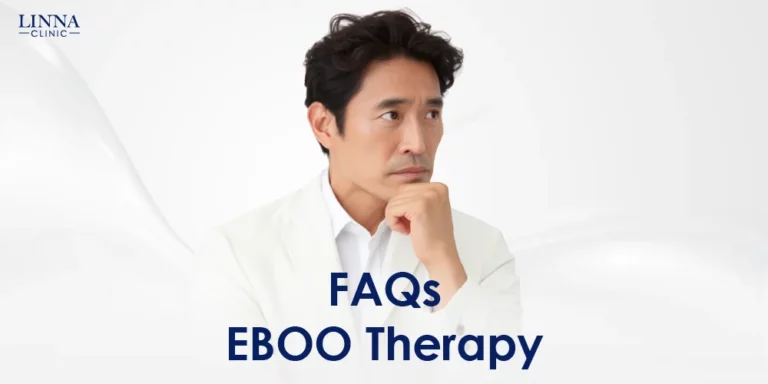EBOO Therapy (Extracorporeal Blood Oxygenation and Ozonation) is a therapy that uses medical grade filter to elimite waste and toxins in your blood and adding medical ozone into your blood, before safely returning it to the body. This process is notable for helping to eliminate toxins, increase oxygen in the blood, and stimulate the immune system. Currently, EBOO Therapy is recognized as a method that helps restore overall health and balance the body safely and effectively. However, many people may have questions about the EBOO Therapy process, including results and precautions before receiving the service. LINNA Clinic has compiled frequently asked questions about EBOO Therapy to provide useful information for those interested in undergoing this therapy.
Table of Contents
How long does an EBOO Therapy session take?
Generally, the duration of an EBOO Therapy session is approximately 45-60 minutes per session. However, the time may vary depending on the strength of the blood vessels, blood flow rate, and individual response to ozone. After the session, the patient can resume normal activities without needing recovery time.
How often should EBOO Therapy be done?
The frequency of EBOO Therapy depends on the patient’s health condition and goals. For those seeking recovery from chronic conditions such as cumulative fatigue, viral or bacterial infections, or chronic inflammation, physicians often recommend EBOO Therapy every 2 weeks to allow the body to recover and respond effectively to the treatment. For patients with specific illnesses or health conditions requiring specialized recovery, physicians may consider weekly sessions for clearer results and can reduce the frequency as health improves to a satisfactory level.
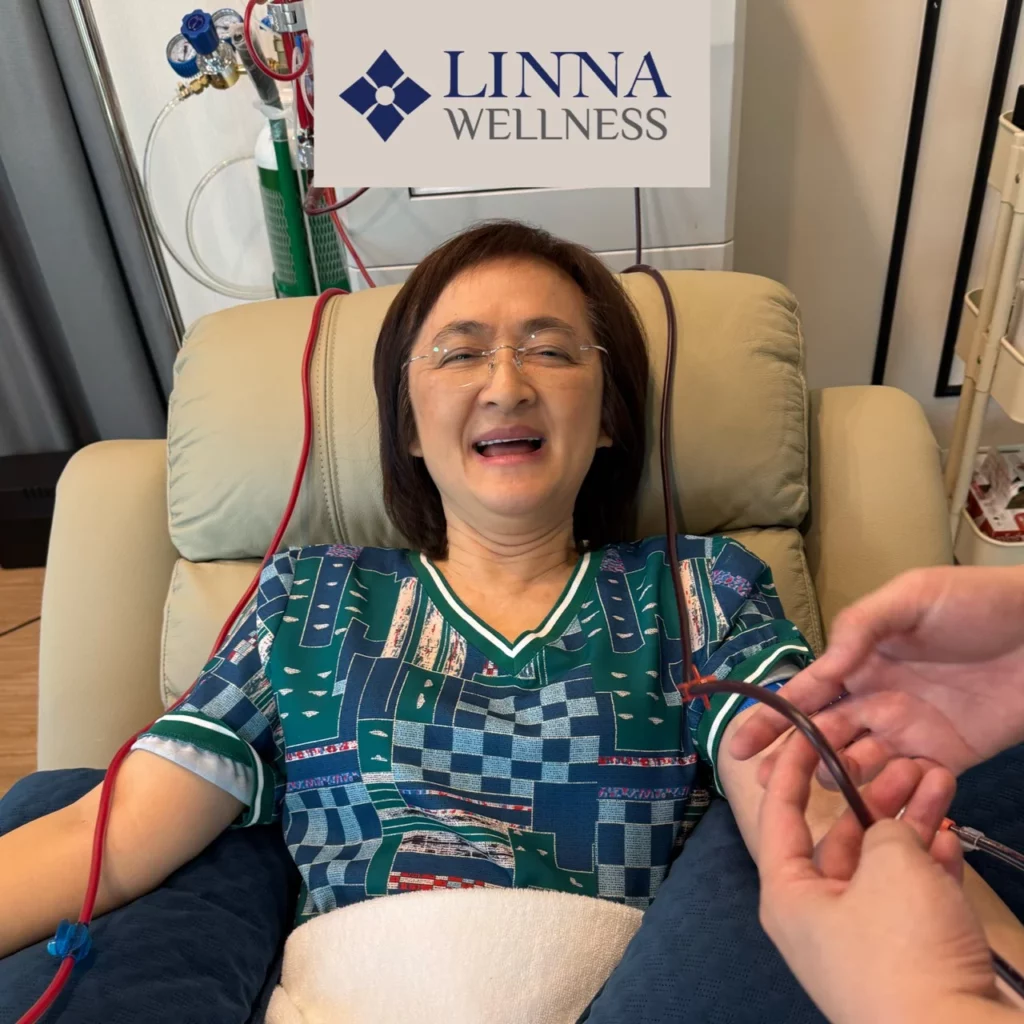
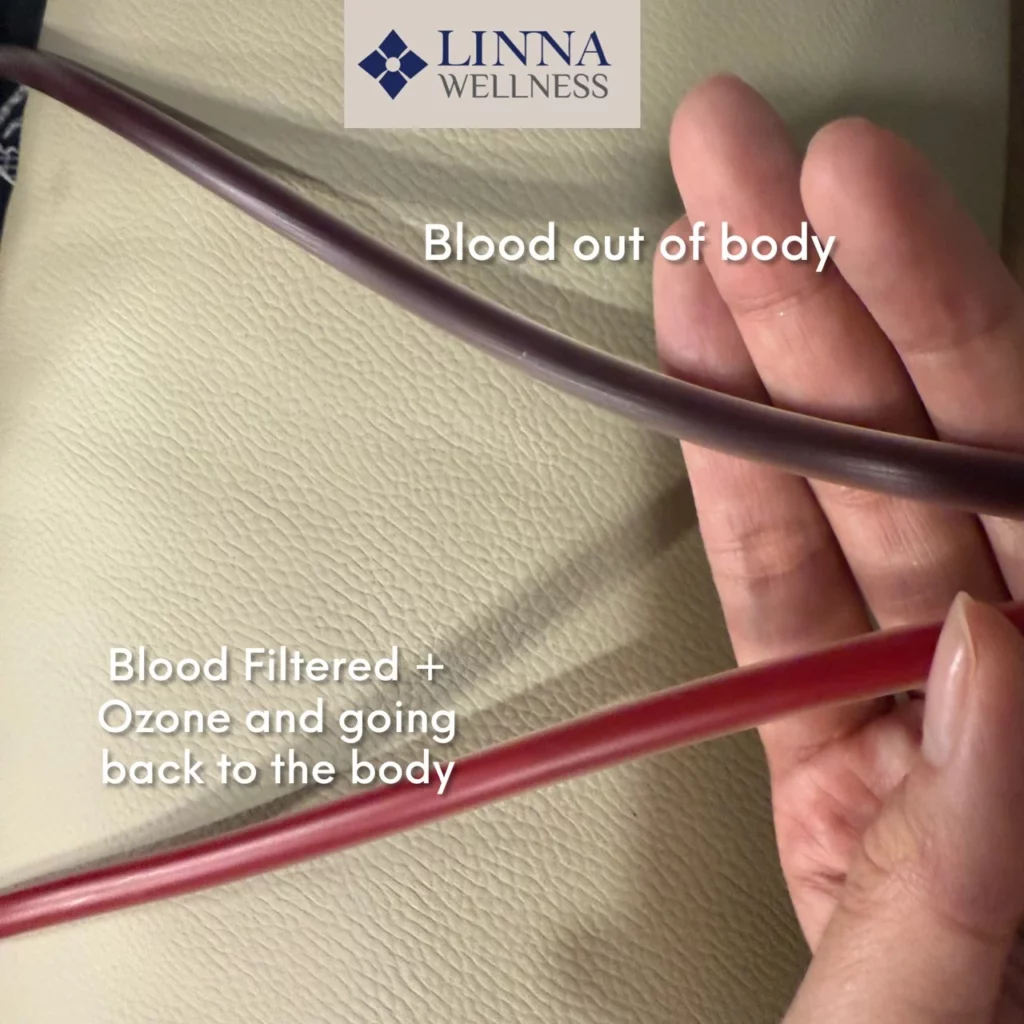
How much blood can be filtered in one EBOO Therapy session?
The amount of blood that can be filtered may vary from person to person, but generally, an EBOO Therapy session of approximately 45-60 minutes can filter 20-25% of the total blood volume.
What are the benefits of EBOO Therapy?
- Stimulates the immune system and increases oxygen in the blood.
- Reduces chronic inflammation and helps regenerate cells, alleviating chronic pain.
- Promotes improved blood circulation.
- Increases energy for body cells, alleviating chronic fatigue.
- Helps remove toxins and waste from the body.
- Promotes radiant and healthy skin.

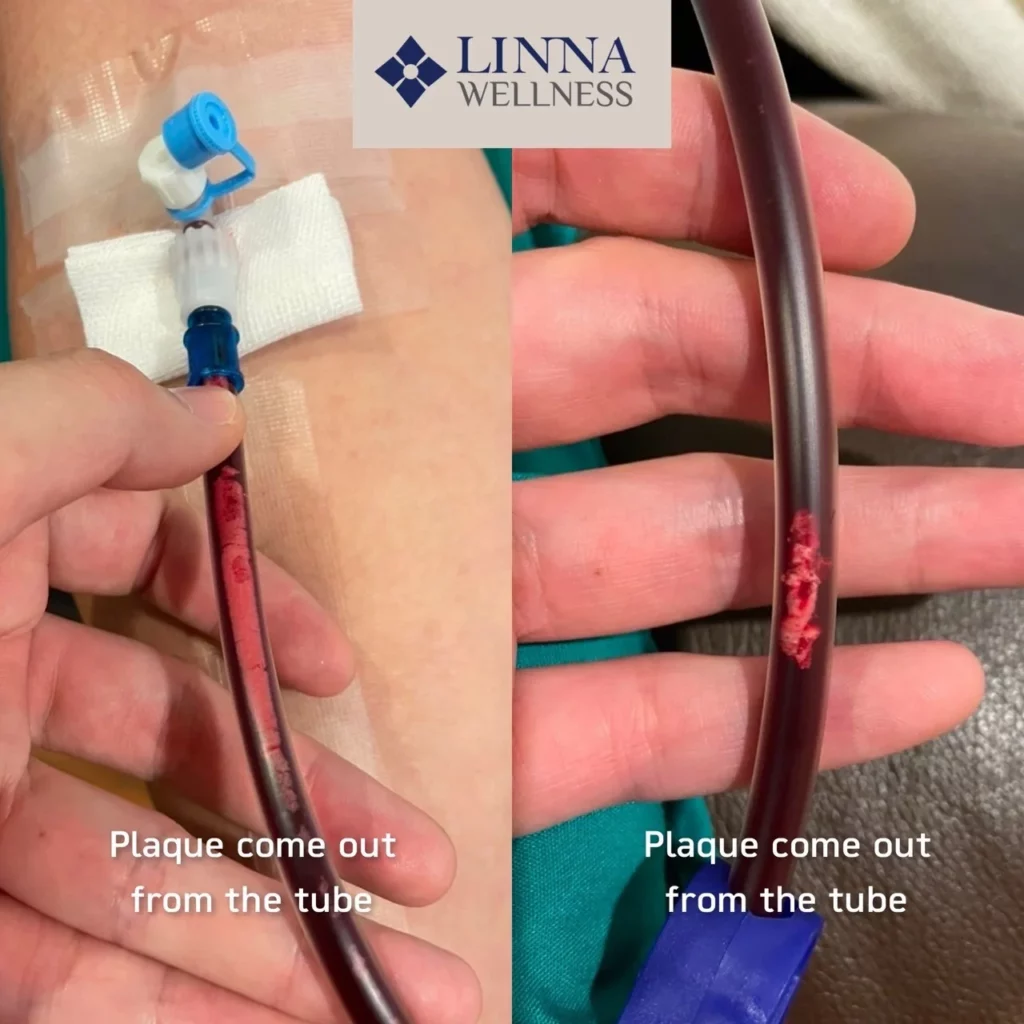
Can individuals with Anemia or Thalassemia undergo EBOO Therapy?
Generally, EBOO Therapy, when not performed under expert supervision, is not suitable for individuals with Anemia or Thalassemia because this therapy involves removing and reinfusing blood, which may directly and indirectly affect red blood cell counts. However, at LINNA Clinic, we have highly experience physicians and team who can tailor the ozone therapy process to suit each individual’s physical condition. We continuously control the ozone concentration at appropriate levels and monitor red blood cell characteristics in real-time, making it safe and effective for patients with anemia and weak red blood cells.
Are EBOO Therapy machines different across clinics?
Although EBOO Therapy is a widely used technique, and the machine’s basic operation may not differ, the efficiency of the technology used by the medical facility and the service provider’s experience are crucial factors affecting the therapy’s effectiveness and safety. This includes the quality of the motor system, the ozone generator, which must be able to control the rate of ozone infusion into the body stably, precisely and accurately, as well as the expertise of doctor and nurse in techniques such as vein cannulation and appropriate blood inflow and outflow control to maintain blood pressure balance, and determining ozone concentration and gas flow rate according to health conditions to ensure patient comfort during the procedure and achieve the best results. Also at Linna Clinic we also ensure the atmostphere that the machines are used is in a good condition which will keep good operating standard of the EBOO machine. For example, control humidity of the air, control room temperature, UV protection, etc. Also we have airpurifiers to keep our patients in a clean air while doing the treatment.
What are the symptoms after EBOO Therapy?
Feelings after EBOO Therapy may vary from person to person. Some patients may feel refreshed and more energetic immediately after the session, with improvements in migraine, dizziness, and vertigo. Others may feel the same or experience fatigue if they drink too little water or do not get enough rest. To ensure a smooth and safe therapy process, patients should undergo a thorough physical examination to assess risks before starting therapy and strictly follow the physician’s recommendations after EBOO Therapy.
How should I prepare before EBOO Therapy?
- Consult with a physician for a thorough physical examination and risk assessment before therapy.
- Get adequate rest, sleeping 6-8 hours.
- Drink plenty of clean water to stimulate blood circulation.
- Refrain from smoking and alcohol for at least 1 day before the session.
- Eat light meal at least 30 minutes before the session to help maintain stable blood sugar levels.
- Avoid taking vitamin C for 1 day before the session, as vitamin C can reduce the reaction of ozone in the body, decreasing the effectiveness of EBOO Therapy. You can resume taking it 1 day after the session.
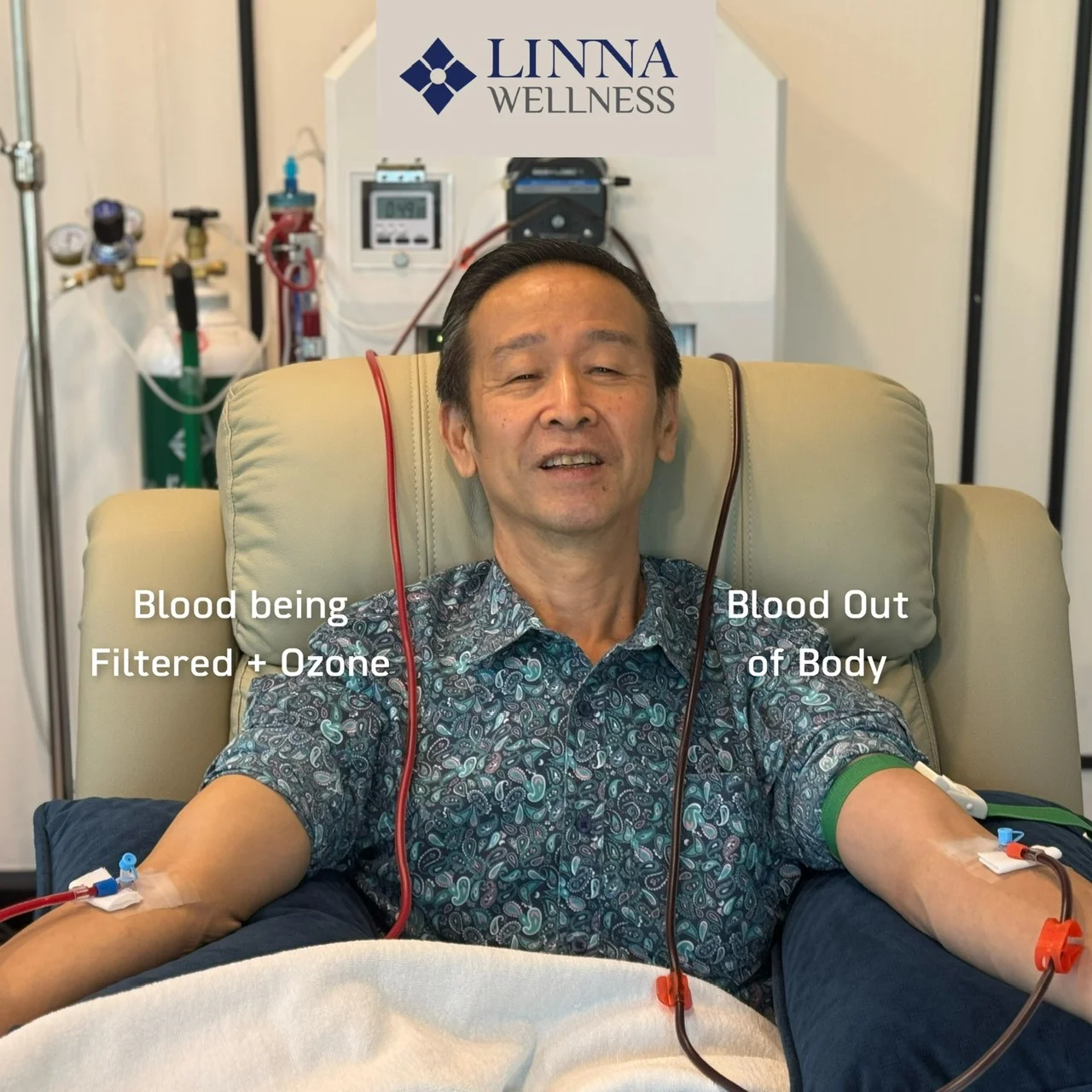
How many EBOO Therapy sessions are optimal?
The frequency of EBOO Therapy depends on blood quality and individual health conditions. If overall health is good without chronic illnesses, EBOO Therapy may be used for occasional health rejuvenation, perhaps once a month or every 2-3 months. For those with health issues or circulatory problems, physicians may increase the frequency to every 1-2 weeks for until health improves to a satisfactory level and then reduce the frequency as needed.
Is headache a normal symptom after EBOO Therapy?
Headaches and dizziness after EBOO Therapy may occur in some individuals due to various reasons, such as ozone sensitivity, post-therapy headaches due to insufficient rest, or dehydration in those who drink too little water before therapy. Headaches are usually temporary and resolve within 24 hours. It is recommended to drink plenty of clean water and get adequate rest to help the body adapt better. If headaches persist or are accompanied by other symptoms such as nausea, vomiting, or fainting, seek medical attention immediately.
Can I undergo EBOO Therapy while fasting?
It is not recommended. EBOO Therapy affects blood sugar levels and circulation. If the body is in a fasting state with lower than normal blood sugar, it may cause dizziness, nausea, vomiting, or severe fatigue after EBOO Therapy.
Can EBOO Therapy help individuals with Ischemic Stroke?
EBOO Therapy is an alternative therapy that may aid recovery in Ischemic Stroke patients by increasing oxygen in the blood and brain, stimulating blood flow, and reducing inflammation, which benefits the patient’s recovery process. However, this therapy is not a direct treatment for ischemic stroke and cannot replace mainstream treatments. Patients should consult their physician to assess risks and ensure the therapy does not interfere with current treatments.
Can I undergo EBOO Therapy if I am not sick?
Healthy individuals without illness can undergo EBOO Therapy for preventive health care, such as boosting the immune system, increasing oxygen levels in body cells for energy recovery, relieving cumulative fatigue, and eliminating toxins or waste. However, this therapy is only one approach to promote overall health and cannot prevent all diseases or illnesses, as disease causes depend on many factors.

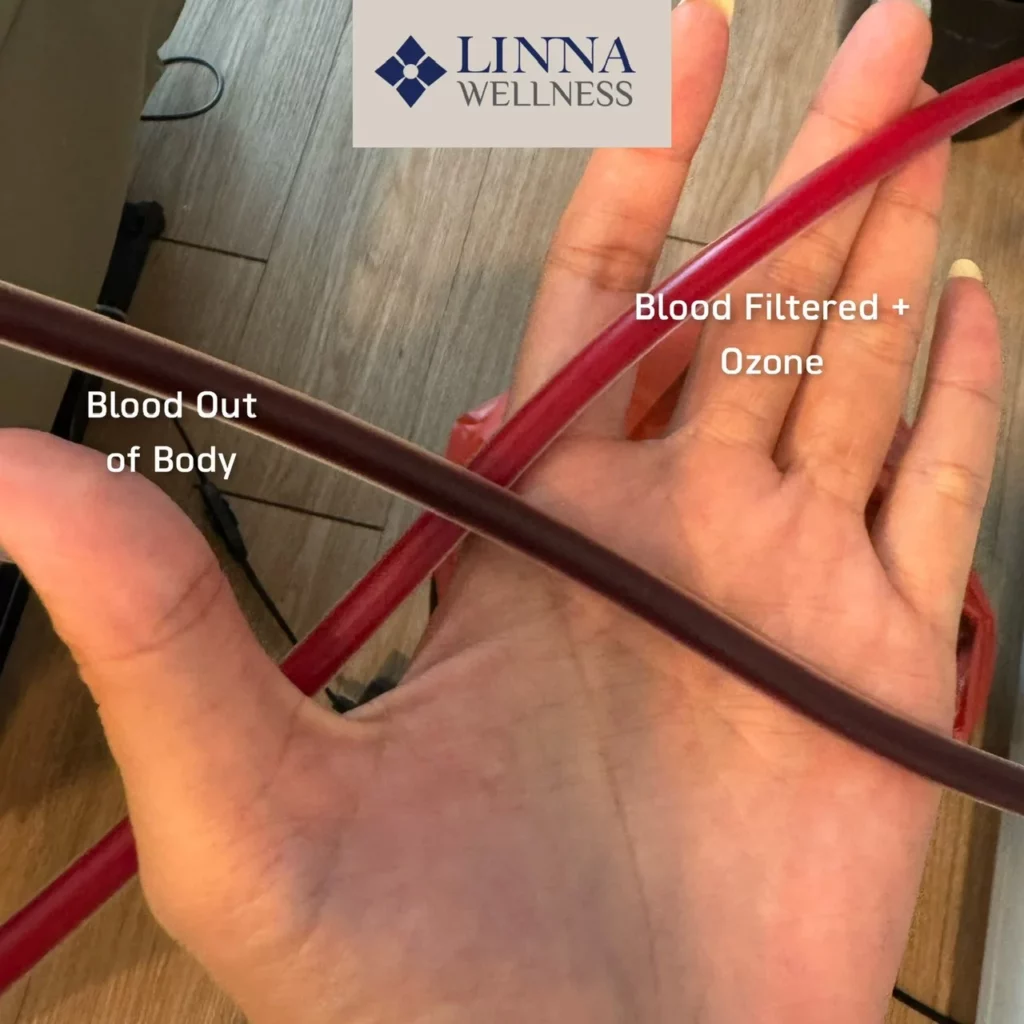
Can cancer patients undergo EBOO Therapy?
Yes, but patients should be aware of health factors and potential risks, as cancer symptoms can change over time even without EBOO Therapy. Ozone therapy increases oxygen levels in the body, which benefit patients since cancer cells often cannot thrive in high-oxygen environments, aiding recovery. In cases of bleeding from tumors, therapy is not recommended to reduce the risk of increased bleeding. Cancer patients should consult the physician before deciding on EBOO Therapy for safety.
Can I undergo EBOO Therapy if I am taking Blood Thinners?
Individuals taking blood thinners may need to stop medication at least 1 day before therapy to reduce the risk of excessive bleeding. However, consult your physician to assess risks and suitability before therapy. Do not stop taking blood thinners on your own.
Can I undergo EBOO Therapy if I am undergoing Hormone Therapy?
Yes, you can. However, as responses to therapy vary, patients should provide detailed information about their health and hormone-related conditions to the physician for risk assessment and appropriate protocol adjustment.
Conclusion:
EBOO Therapy is a treatment technique that provides benefits both for patients in need of physical recovery and for healthy individuals who wish to maintain and protect their well-being. However, anyone interested in EBOO Therapy should first consult with a doctor and undergo a thorough health evaluation to identify any risks and develop a treatment plan tailored to their specific health condition.
For more information about Ozone Therapy (EBOO PLUS Technique), please feel free to add us on LINE: @linnaclinic or contact us at 063-609-8888. Our experienced medical team, with over 12 years of expertise and more than 30,000 successful treatment cases, is ready to take care of you every step of the way.

